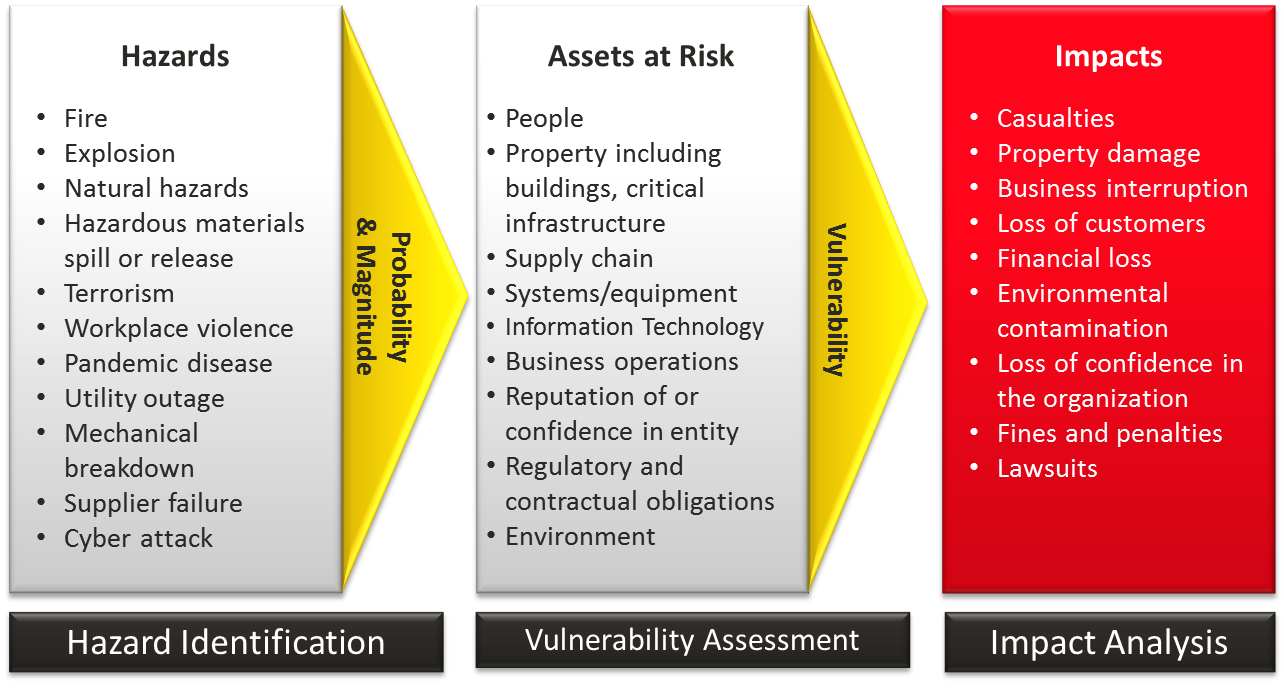A crucial step in preparedness for your practice in the even of a emergency or disaster is a Risk Assessment.
A risk assessment is a process to identify potential hazards and analyze what could happen if a hazard occurs. A business impact analysis (BIA) is the process for determining the potential impacts resulting from the interruption of time sensitive or critical business processes.
As an employer, make sure your workplace has a building evacuation plan that is regularly practiced. The preparedness program is built on a foundation of management leadership, commitment and financial support. Without management commitment and financial support, it will be difficult to build the program, maintain resources and keep the program up-to-date.
Implementation
Write a preparedness plan addressing:
- Resource management
- Emergency response
- Crisis communications
- Business continuity
- Information technology
- Records Managment
- Employee assistance
- Incident management
- Training

Find more information on Implementation here.
Testing And Exercises
- Test and evaluate your plan
- Define different types of exercises
- Learn how to conduct exercises
- Use exercise results to evaluate the effectiveness of the plan
Find more information on Testing and Exercises here.
Program Improvement
- Identify when the preparedness program needs to be reviewed
- Discover methods to evaluate the preparedness program
- Utilize the review to make necessary changes and plan improvements
Find more information on Program Improvement here.
Visit the Deparment of Homeland Securities Business site for more information.
- Take a critical look at your heating, ventilation and air conditioning system to determine if it is secure or if it could feasibly be upgraded to better filter potential contaminants, and be sure you know how to turn it off if you need to.
- Think about what to do if your employees can't go home.
- Make sure you have appropriate supplies on hand.
- Read more at Build a Kit and Staying Put.
There are numerous hazards to consider. For each hazard there are many possible scenarios that could unfold depending on timing, magnitude and location of the hazard. Consider hurricanes for an example. A Hurricane forecast to make landfall near your business could change direction and go out to sea. The storm could intensify into a major hurricane and make landfall.
There are many “assets” at risk from hazards. First and foremost, injuries to people should be the first consideration of the risk assessment. Hazard scenarios that could cause significant injuries should be highlighted to ensure that appropriate emergency plans are in place. Many other physical assets may be at risk. These include buildings, information technology, utility systems, machinery, raw materials and patient records. The potential for environmental impact should also be considered. Consider the impact an incident could have on your relationships with customers, the surrounding community and other stakeholders. Consider situations that would cause patients to lose confidence in your organization and its services or protection of vital records.
There are many “assets” at risk from hazards. First and foremost, injuries to people should be the first consideration of the risk assessment. Hazard scenarios that could cause significant injuries should be highlighted to ensure that appropriate emergency plans are in place. Many other physical assets may be at risk. These include buildings, information technology, utility systems, machinery, raw materials and patient records. The potential for environmental impact should also be considered. Consider the impact an incident could have on your relationships with customers, the surrounding community and other stakeholders. Consider situations that would cause patients to lose confidence in your organization and its services or protection of vital records.
As you conduct the risk assessment, look for vulnerabilities—weaknesses—that would make an asset more susceptible to damage from a hazard. Vulnerabilities include deficiencies in building construction, process systems, security, protection systems and loss prevention programs. They contribute to the severity of damage when an incident occurs. For example, a building without a fire sprinkler system could burn to the ground while a building with a properly designed, installed and maintained fire sprinkler system would suffer limited fire damage.
The impacts from hazards can be reduced by investing in mitigation. If there is a potential for significant impacts, then creating a mitigation strategy should be a high priority.

Use the FEMA Risk Assessment Tool to complete your risk assessment. Instructions are provided on the form.
Please also request the supplementary and supportive HCSI HIPPA Security Risk Analysis health checkup checklist to coincide with your office risk assessment or by clicking here HCSI Support - Risk Anlysis or entering your email address in the top right side of the blog.
Source(s): http://www.hcsiinc.com, https://www.ready.gov/, http://www.fema.gov/
Please also request the supplementary and supportive HCSI HIPPA Security Risk Analysis health checkup checklist to coincide with your office risk assessment or by clicking here HCSI Support - Risk Anlysis or entering your email address in the top right side of the blog.
Source(s): http://www.hcsiinc.com, https://www.ready.gov/, http://www.fema.gov/




Employers are able to find a pool of experienced job seekers, while applicants can benefit by finding placement in well-respected facilities. sonic diabetic options
ReplyDeleteThey are swift problem solvers, typically anticipating problems before they occur, and employ a team of seasoned, knowledgeable logistics experts to manage both high level and detailed logistics solutions. order Endocet 10 325 Online
ReplyDelete